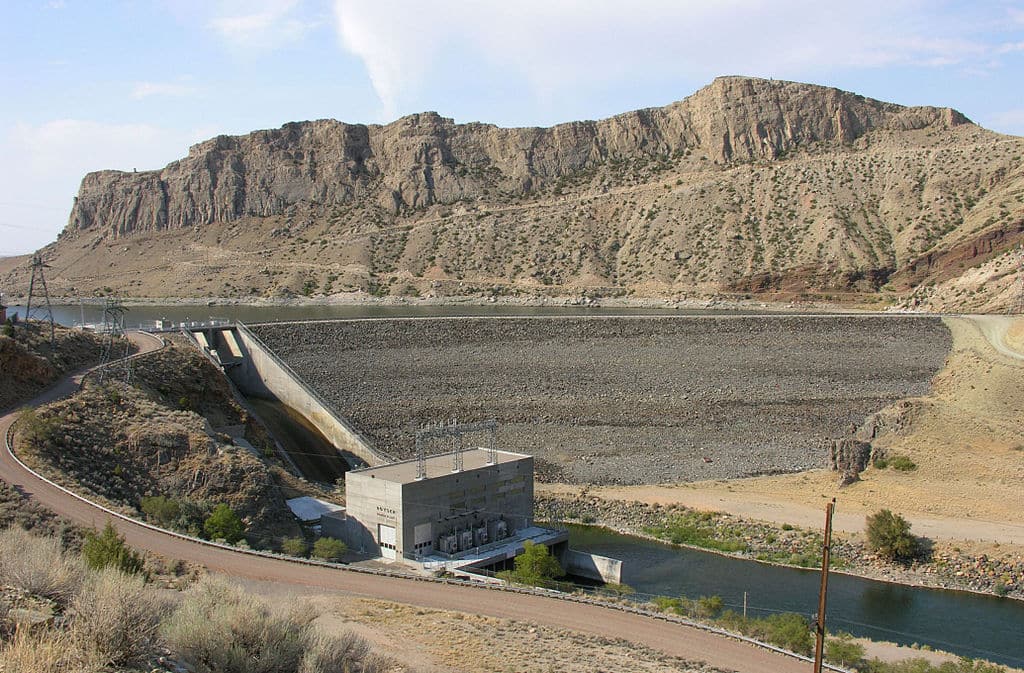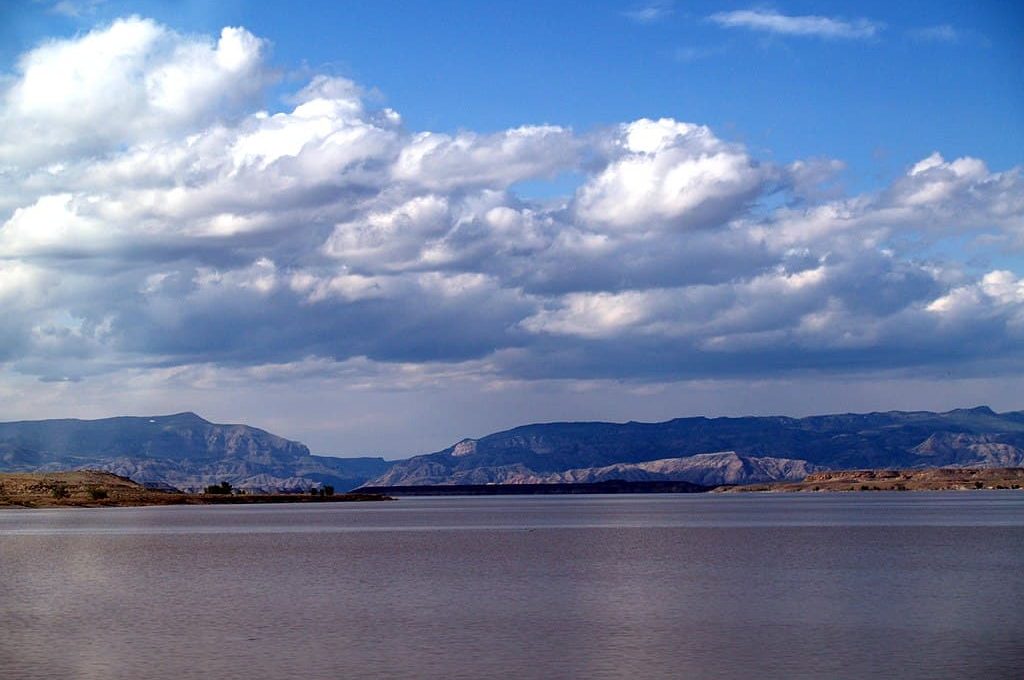Boysen Reservoir Fishery includes a section of the Wind River from the Boysen Dam (N43.40732 W108.17070) through the Wind River Canyon. It then continues to the Wedding of the Waters (N43.58908 W108.21604) and on into the Big Horn River up through the town of Thermopolis, then continuing about nine miles beyond the town. The total fishery length is 30 miles.
Location
Not so far out of Yellowstone Parks Eastside, in the NW quadrant of Wyoming, lies the town of Thermopolis N43.64585 W108.21130, the kick-off point for reaching the Fishery that includes a section of the Wind River and the Big Horn River, joined at the famous Wedding of the Waters.
Traveling out of Casper, Wyoming, take US Hwy 20 North to Thermopolis and in doing so, you will travel up a part of the Fishery through the beautiful Wind River Canyon. The other direction of travel is to come out of Cody, Wyoming, down State Hwy 120. Either direction of travel is about 90 miles.
Species At This Location
- Trout Brown
- Trout CutThroat
- Trout Rainbow
Accommodation
Given the proximity of Thermopolis, three miles, it is an easy place to pick up a permit. Thermopolis also boasts quite a few other attractions to go with this Blue Ribbon Fishery. It is home to the largest mineral hot springs in the world.
The springs are located in Hot Springs State Park right in town and offer recreational swimming, slides, and other water fun attractions at the swimming center. There are a number of good small eateries at the hotels, in town, and at the airport, along with a number of national franchise fast food places. Pretty good for a town of a little over 3,500 folks!
When you come, make hotel reservations ahead of time. The popularity of the Hot Springs Park for family activities and other area attractions, along with the fishing, fills up the rooms pretty quickly.
Boysen Reservoir Fishing Description
Boysen Reservoir fishery can be broken down into four segments covering walk/wade/float fishing:
Segment One winds from the Boysen Dam through the Boysen State Park campgrounds and finally ends at the start of the Wind River Canyon. This is a walk/wade section.

Segment Two is the Wind River Canyon itself, which is mostly a wade with a little bit of walk to it.
Segment Three runs from the Wedding of the Waters boat ramp to the Hot Springs State Park boat ramp and is usually a float section.
Segment Four is from the Hot Springs State Park boat ramp downriver another nine miles.
These four segments share commonalities while still having some distinct differences in how they fish and what’s in them. They all share a really good fishing experience.
An interesting note here is that the Wind River becomes the Big Horn River at the Wedding of the Waters. At this point, you move from being on the Wind River Indian Reservation to not being on the reservation.
The reservation area requires a special permit to fish it. The permit can be obtained from a number of places such as local hardware stores and generally any tackle shop in the town of Thermopolis.
As you start through Segment One, up in the Boysen State Park area, the Fish Per Mile (FPM) estimate is 2,400. These are slow-moving waters but still are powerful and can be dangerous to the inattentive. Finning their way through the current will be browns, rainbows, and cutthroats. Average lengths run from 16 to 19 inches, with up to 34-inch catches possible. You can hook ’em, but the real chore is getting them into the net.
Fishing through this blend of big fish, strong lines and tippets will work just fine on nymphs and the like, so put away the 5X. You don’t need it and it will probably break off anyway.
As mentioned earlier, this is a walk/wade stretch. There is not a lot of structure and you will get around with reasonable effort.
In Segment Two, the Wind River Canyon, the water really gets moving. The big boulders, and the really big boulders, are now present along with some very large fish. Typically, when you can get one on, it is going to be over 20 inches.
Along with the standard stuff, this is a good section for putting a stonefly on. However, streamers are probably the best in this section. Nymphs will work sometimes.
Come summer, try cicada imitations, big attractors, hoppers, and other big stuff. The FPM is likely around 1,600.
Remember, this section requires a special permit for fishing on the reservation.
Segment Three runs from The Wedding of the Waters (N43.58908 W108.21604) to Hot Springs State Park (43.65497 W108.19859) and boasts a wider channel and slower water. The structure in the water column is not so diverse but the FPM rises to about 2,200. This is great dry fly territory and just plain fun to fish. This is a flat area that can offer walk/wade, but a drift boat ride is a better deal for productivity and better coverage.
Segment Four runs from the Hot Springs State Park boat ramp, about another nine miles downstream. This would be 13.1 miles North of the Thermopolis City sign on Rte 20.
At the boat ramp point in the Hot Springs State Park, the hot springs flow into the river creating a major jump up in temperature. This is not so good for summer fishing but does amazing things for winter fishing. While the FPM is only about 800, the fish size is pigs unlimited.
The ride doesn’t offer so much scenery but you are pretty much looking at the water, so who cares? This section is not too good for walking/wading, as it is almost all private land, but a drift boat is OK for passage and the best way to fish it regardless.
Size
The Fishery runs a total of about thirty miles and has several public access points in the first three segments but limited public access in the fourth segment.
Weather
Mean Temperatures: Jan 2o, Feb 27, Mar 37, Apr 45, May 54, Jun 63, Jul 70, Aug 69. Sep 59, Oct 47, Nov 22, Dec 22. These are the mean temperatures for the days.
The area generally has good and pleasant weather. Daytimes in the summer can get quite warm, into the nineties, but still, cool down quite a bit at night. As the winter months approach, temperatures can really take a nosedive. Winter can also bring snows that shut down the highways so planning ahead is important.
Probably two of the best months for being in the area to fish are September and October.
Fishing Methods
This fishery is primarily a fly fishing area, although other methods are occasionally employed. Most spin fishing or baitcasting is more suited to the Boysen Reservoir itself.
The important items of note in successfully working this fishery are to 1.) Use good conservation methods to promote the fishery, 2.) Use responsible angling methods of single hook rigs with the barbs taken off, and 3.) Understand working on moving water.
The River system has strong flows and lends itself to methods that take advantage of working lures in motion through drifts which tends to favor fly fishing although some limited spin casting techniques, most notably float and fly rigs, will work.
Rods that can handle the hit of a big fish and protect the leader are the best choices, so a medium to medium-fast rod of 9 feet to 10 feet in length makes a wise choice. Line strengths of 20 lbs and tippets in the 3X range for nymphs or emergers do a good job. Topwater drys will need to look at 4X to 5X sizes to be effective.
The river accommodates wading very well with some areas of bank walking, particularly in the lower sections on the Wind while drift boats will better serve you on the upper two segments in the Big Horn. The third segment will accommodate some walking, but the fourth segment being almost all private is not a reasonable area to attempt walking or wading.
Season
When taking on these waters, the first thing that jumps to mind is seasonality and with the seasons, hatches.
The fishing season is open all year round, but winter conditions can close the area to travel and create inclement conditions not suitable for being in the elements.
It is strongly recommended that you consult with local folks about the specifics involved for the time of year you are considering going. We’ll guarantee one thing: No matter when you go, you will love the area and the experience.
January through February is primarily a midge time, with nymphs in play as a second offering. Sowbugs in traditional pink along with scuds do well. Olive and tan colors can work as well. As the weather warms up slightly during the day, it is possible to see Blue Winged Olives (BWOs) on the water, and streamers such as the wooly bugger can bring in results.
March and April will let you still use the sows, scuds, and midges but the real explosion especially in the front end of March is the BWOs.
May brings on the Tricos. Usually, the Trico bloom is from around 5 a.m. to 10 a.m. The bottom bugs are still there, too, so stay with that as well.
Summer will see the BWOs and the Tricos, just not as heavy. Also, during this time, the water level may rise which can slow down the dry fly effort but is still good for hoppers, beetles, and ants. Plus, the mayflies are flitting.
September and October bring the return of the BWO explosion, and then it’s back to the usual stuff described above of the winter season. Keep in mind that in the winter, snow, ice, and freezing temps can plain put an end to fishing some days.
It is a good idea to check the weather and talk to some guides and fishing shop folks about outlooks.
Fish it for a few hours or a few days. You can pick your challenges and opportunities on the Wind River/Lower Big Horn Fishery, a unique piece of geography and history.
Whether you take yourself or get the advantage of a professional guide, you are in for a treat almost any time of year.

